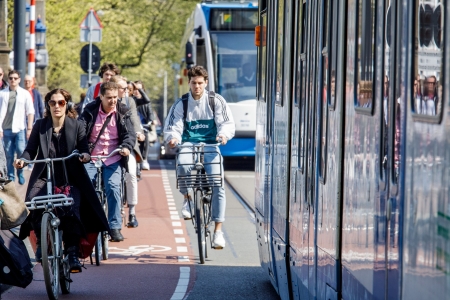Below you will find the list of references that are used in this fact sheet. All sources used can be consulted or retrieved via our Library portal. Here you can also find more literature on this subject.
[1]. RvTV (2000). Veiligheidsrisico’s van de Nederlandse stadstram. Raad voor de Transportveiligheid, Den Haag.
[2]. Temürhan, M. & Stipdonk, H.L. (2016). Touringcars en verkeersveiligheid. Vergelijking van de veiligheid van bussen met auto’s [Coaches and road safety. Safety of coaches and cars compared]. R-2016-18. [Summary in English]. SWOV, Den Haag.
[3]. Brenac, T. & Clabaux, N. (2005). The indirect involvement of buses in traffic accident processes. In: Safety Science, vol. 43, nr. 10, p. 835-843.
[4]. Davidse, R.J., Mesken, J. & Schoon, C.C. (2004). Ongevallen met bussen. Een verkennende studie aan de hand van Connexxion-dossiers [Accidents with busses. An exploratory study using Connexxion files]. D-2003-14.[Summary in English]. SWOV, Leidschendam.
[5]. Stoop, J.A.A.M. (2008). Onderzoek en interviews veiligheid stadstrams. Kindunos Veiligheidskundig Adviesbureau B.V. in opdracht van ministerie van Verkeer en Waterstaat, DGP, Gorinchem.
[6]. Arcadis (1998). Overweg met de sneltram. Onderzoek naar de veiligheid van sneltramkruisingen. Eindrapport 672/CE98/1733/13479. Arcadis in opdracht van Ministerie van Verkeer en Waterstaat, Directoraat Generaal Goederenvervoer, Rijksverkeersinspectie (RWS, DGG, RVI), Den Haag.
[7]. Roeleveld, R.M. (2017). Botsende concessies: een onderzoek naar structurele oorzaken van incidenten tussen trams en zwakkere verkeersdeelnemers binnen het vervoersgebied van HTM. Contribution to the Nationaal verkeerskundecongres 2017, 1 november 2017, Zwolle.
[8]. Schagen, I.N.L.G. van & Aarts, L.T. (2018). DV3 – Huidige situatie, maatschappelijke trends en wensbeelden. Kader voor de visie Duurzaam Veilig Wegverkeer 2018-2030 [Sustainable Safety version 3 – current situation, societal trends and ideals. Framework for the second advanced Sustainable Safety vision for the period 2018-2030. R-2018-6A.[Summary in English]. SWOV, Den Haag.
[9]. Hertach, P., Uhr, A., Niemann, S. & Cavegn, M. (2018). Characteristics of single-vehicle crashes with e-bikes in Switzerland. In: Accident Analysis & Prevention, vol. 117, p. 232-238.
[10]. Maempel, J.F., Mackenzie, S.P., Stirling, P.H.C., McCann, C., et al. (2018). Tram system related cycling injuries. In: Archives of orthopaedic and trauma surgery, vol. 138, nr. 5, p. 643-650.
[11]. Goh, K.C.K., Currie, G., Sarvi, M. & Logan, D. (2014). Bus accident analysis of routes with/without bus priority. In: Accident Analysis & Prevention, vol. 65, p. 18-27.
[12]. Zwerts, E., Keppens, M., Adriaensen, J., Mol, J. de, et al. (2009). Verkeersveiligheid op vrije tram-en busbanen. Universiteit Gent. Instituut voor Duurzame Mobiliteit, Gent / ARCADIS Belgium, Antwerpen.
[13]. CROW (2007). Leidraad inpassing trams in stedelijk gebied: is de uitzonderingspositie van de tram qua snelheid en voorrang houdbaar bij Duurzaam Veilige inrichting? Publicatie No. 249. CROW Kenniscentrum voor verkeer, vervoer en infrastructuur, Ede.
[14]. RvTV (2003). De 'vrije' trambaan. Veiligheidsstudie tramongevallen: botsveiligheid, infrastructuur en de bestuurlijke factoren. Raad voor de Transportveiligheid, Den Haag.
[15]. Nævestad, T.O., Elvik, R., Milch, V., Karlsen, K., et al. (2020). Trafikksikkerhet i busstransport: En analyse av kravene som Ruter stiller til bussoperatørene i kontrakter. Transportøkonomisk institutt, Oslo.
[16]. Weber, T., Muser, M. & Schmitt, K.U. (2015). Optimising the design of tramways to mitigate injury risk in pedestrian impacts. In: IRCOBI Conference Proceedings.
[17]. ILT (2018). Veiligheid op het spoor. Jaarverslag Spoorwegveiligheid 2017. Inspectie Leefomgeving en Transport, Ministerie van Infrastructuur en Waterstaat, Den Haag.
[18]. OvV (2018). Overwegveiligheid. Een risicovolle kruising van belangen. Onderzoeksraad voor Veiligheid, Den Haag.
[19]. Rijksoverheid (2020). Wanneer moet ik de autogordel gebruiken? Ministerie van Infrastructuur en Waterstaat. Accessed on 10-04-2020 at www.rijksoverheid.nl/onderwerpen/verkeersveiligheid/vraag-en-antwoord/wanneer-moet-ik-de-autogordel-gebruiken.
[20]. NRC.nl (2017). Waarom hoef je geen gordel om in bus en trein? Accessed on 18-02-2020 at www.nrc.nl/nieuws/2017/03/07/waarom-hoef-je-geen-gordels-om-in-bus-en-trein-7153759-a1549173.
[21]. Albertsson, P., Falkmer, T., Kirk, A., Mayrhofer, E., et al. (2006). Case study: 128 injured in rollover coach crashes in Sweden—Injury outcome, mechanisms and possible effects of seat belts. In: Safety Science, vol. 44, nr. 2, p. 87-109.
[22]. RSSB (2007). Passenger containment: a review of research carried out by RSSB on behalf of the rail industry and core recommendations. Rail Safety and Standards Board (RSSB) Limited, London.
[23]. Asociación RUVID (2012). Safety of standing passengers in urban buses. ScienceDaily. Accessed on 18-02-2020 at www.sciencedaily.com/releases/2012/10/121022080357.htm.
[24]. Elvik, R. (2019). Risk of non-collision injuries to public transport passengers: Synthesis of evidence from eleven studies. In: Journal of Transport & Health, vol. 13, p. 128-136.
[25]. Li, D., Zhao, Y., Bai, Q., Zhou, B., et al. (2017). Analyzing injury severity of bus passengers with different movements. In: Traffic injury prevention, vol. 18, nr. 5, p. 528-532.
[26]. Silvano, A.P. & Ohlin, M. (2019). Non-collision incidents on buses due to acceleration and braking manoeuvres leading to falling events among standing passengers. In: Journal of Transport & Health, vol. 14, p. 100560.
[27]. Aarts, L.T. & Bos, N.M. (2019). Ernstige verkeersongevallen met taxi’s. Een analyse over de periode 2001-2018 in Nederland en een aantal Nederlandse gemeenten. R-2019-12. SWOV, Den Haag.
[28]. AD (2019). Flitsmeister waarschuwt nu ook voor gevaarlijke overwegen. Algemeen Dagblad. Accessed on 17-02-2020 at www.ad.nl/binnenland/flitsmeister-waarschuwt-nu-ook-voor-gevaarlijke-overwegen~a683558f/.
[29]. Volkskrant (2018). ProRail gaat op eigen initiatief onbewaakte overwegen afsluiten. Volkskrant. Accessed on 27-03-2020 at www.volkskrant.nl/nieuws-achtergrond/prorail-gaat-op-eigen-initiatief-onbewaakte-overwegen-afsluiten~b61b3b6a/.
[30]. ProRail (2018). Jaarverslag 2017. Verbindt. Verbetert. Verduurzaamt. ProRail B.V., Utrecht.
[31]. ProRail (2019). Slimme camera’s tegen gevaarlijk gedrag op overwegen. ProRail. Accessed on 18-02-2020 at www.prorail.nl/nieuws/slimme-camera-s-tegen-gevaarlijk-gedrag-op-overwegen.
[32]. CROW (2010). Addendum Handboek Halteplaatsen. CROW publicatie 233. CROW Kenniscentrum voor verkeer, vervoer en infrastructuur, Ede.
[33]. OvV (2008). Ontsporingen bij RandstadRail. Onderzoeksraad voor Veiligheid OvV, Den Haag.
[34]. SpoorPro (2019). Prorail vreest spoorspattingen door hitte. SpoorPro. Vakblad voor de spoorsector. Accessed on 18-02-2020 at www.spoorpro.nl/spoorbouw/2019/06/24/prorail-vreest-spoorspattingen-door-hitte/?gdpr=accept.
[35]. Connekt (2010). Dodehoek Detectie- en Signalerings Systemen (DDSS): Onderzoek naar de werking en de mogelijkheden. Connekt, Delft.
[36]. Sirry, A.M., Kargbo, A., Martinovic, D., Luga, F., et al. (2018). Autonomous pedestrian detection in transit buses. Worcester, Worcester Polytechnic Institute.

 Figure 1. Distribution of the registered number or road deaths by mode of transport in crashes with a bus
Figure 1. Distribution of the registered number or road deaths by mode of transport in crashes with a bus

